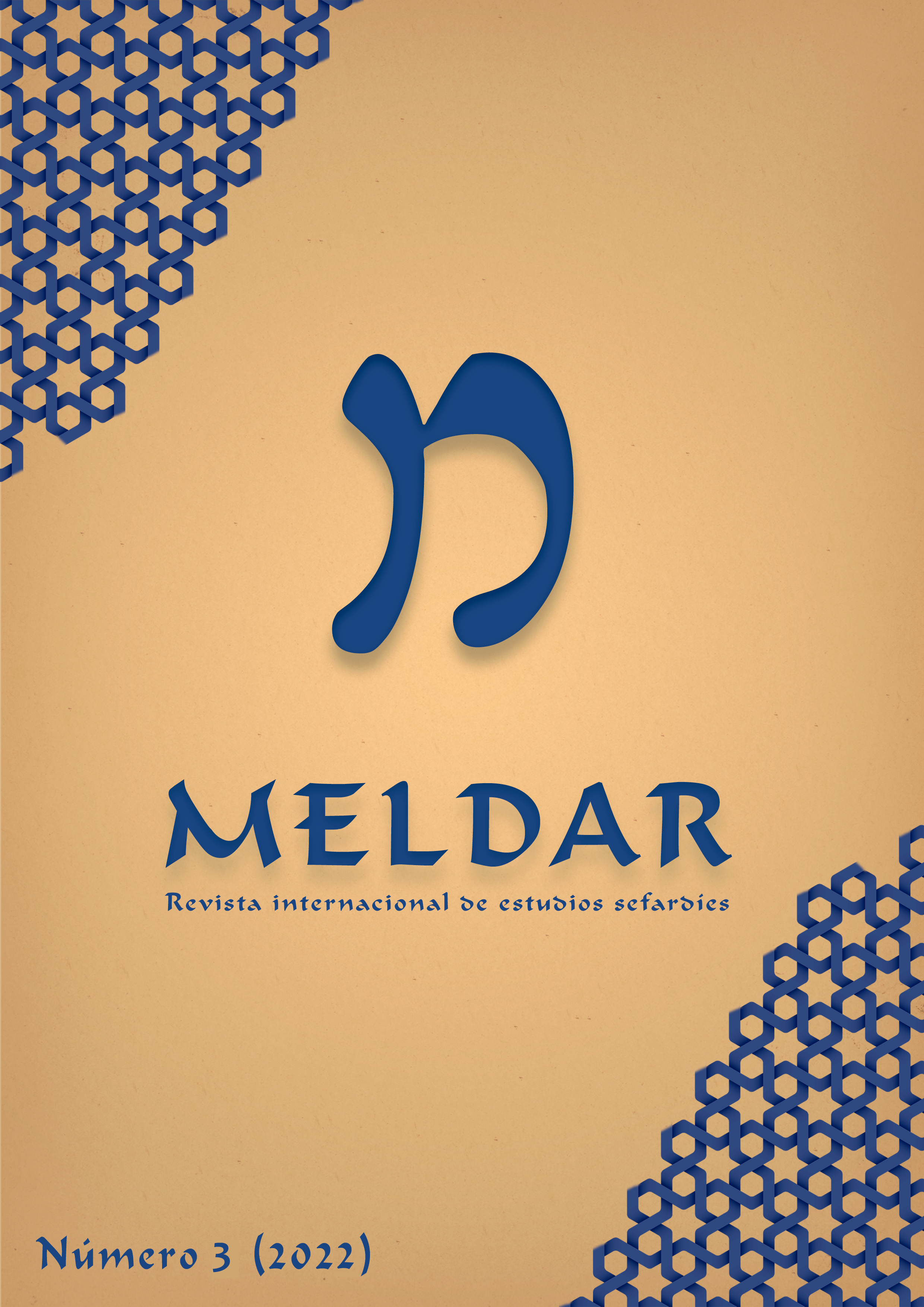Pluma/Espuma: Four Sonetos in a Unicum from Ottoman Smyrna (1659) and their Historical Context
DOI:
https://doi.org/10.46661/meldar.6547Keywords:
Sephardi editors, Sephardi poets, Abraham Gabbai, Isaac Moron, Daniel de Sylva, Ottoman Sephardi CultureAbstract
Four sonnets by Isaac Moron and Daniel de Sylva are printed in the unicum published by Abraham Gabbai at the Kaf Nahat press in Smyrna. To explain the apparently unconventional phenome-non, a historical contextualization of the Sephardi community of the printer and the poets is suggested. The general and communal history of Smyrna at this time, the culture of the consuls and the close relationship of Smyrna Jews with them and with other culturally relevant figures such as travelers or book collectors explains some of the background. Even in Hebrew texts of that time and place one can find samples of a deeper and relatively complex Hispanism than has been understood until now. The analysis of the sonnets reveals their affinity with the Spanish literature of Amsterdam, with the Iberian reception of the classical tradition and with the esthetic, stylistic and intellectual presuppositions current in the Iberian Peninsula of the 17th c.
Downloads
References
Abramsky, Chimen. (1988). Lucien Wolf’s efforts for the Jewish communities in Central and Eastern Europe. Jewish Historical Studies, 29, 281-295
Anderson, Sonia P. (1989). An English consul in Turkey: Paul Rycaut at Smyrna, 1667-1678. Oxford: Clarendon.
Attias, Moshe. (1947). Sefer shirot ve-tishbahot shel ha-shabtaim, transcribed by M. Attias, introduced by Y. Ben-Zvi, and annotated by G. Scholem. Tel Aviv: Dvir.
Barnai, Jacob. (2000). Shabtaut: Hebetim Hevratiim. Jerusalem: Shazar.
Barnai, Jacob. (1982). Portuguese Marranos in Smyrna in the 17th century. In Proceedings of the Eighth World Congress of Jewish Studies (pp. 85-88). Jerusalem: World Union of Jewish Studies.
Bashan, Eliezer. (1982-1986). Contacts between Jews in Smyrna and the Levant Company of London in the seventeenth and eighteenth centuries. Jewish Historical Studies, 29, 53-73.
Beverley, John R. (1973). Soledad Primera, Lines 1-61. Modern Language Notes, 88, 233-248. https://doi.org/10.2307/2907510
Biase, Carmine Di (ed.). (2006). Travel and Translation in the Early Modern Period. Amsterdam: Rodopi. https://doi.org/10.1163/9789401201957
Boogert, Maurits H. van den. (2007). Freemasonry In Eighteenth-Century Smyrna? A Critical Analysis Of Alexander Drummond’s Travels (1754). In Maurits H. van den Boogert (ed.), Ottoman Smyrna: Studies in Honour of Alexander H. de Grootmore (pp. 103-121). Leiden: NINO.
Boogert, Maurits H. van den. (2005). The Capitulations and the Ottoman legal System. Qadis, Consuls and Beratlıs in the 18th Century. Leiden: Brill. https://doi.org/10.1163/9789047406129
Bornstein Markovetski, Leah. (1985). The Jewish Community of Istanbul in mid-17th Century-Its Sephardi and Romaniote Personalities and Sages. Michael, 9, 27-54.
Bosworth. C. Edmund. (2007). Historic Cities of the Islamic World. İzmir: Leiden: Brill. https://doi.org/10.1163/ej.9789004153882.i-616
Bravo Vega, Julián. (1991). Fortuna de una rima áurea: Pluma(s)-Espuma(s). Cuadernos de Investigacion Filologica, 17, 35-87. https://doi.org/10.18172/cif.2299
Bregman, Dvora. (1998). Sror Zehuvim Sonetim Ivriim mi-tequfat ha-renaissance we-ha-baroque. Jerusalem: Ben Zvi.
Bulut, Mehmet. (2002). The Role of the Ottomans and Dutch in the Commercial Integration between the Levant and Atlantic in the Seventeenth Century. Journal of the Economic and Social History of the Orient, 45 (2), 197-230. https://doi.org/10.1163/156852002760247113
Cabello Balboa, Miguel. (2011). Miscelánea antártica [Edición, introducción y notas de Isaías Lerner]. Sevilla: Fundación José Manuel Lara.
Chang-Rodríguez, Raquel. (2011). El Inca Garcilaso y sus “Comentarios reales”. Entre la espada y la pluma. Lima: Fondo Editorial de la Pontificia.
Cogley, Richard W. (2007). Some Other Kinde of Being and Condition: The Controversy in Mid-Seventeenth-Century England over the Peopling of Ancient America. Journal of the History of Ideas, 68 (1), 35-56. https://doi.org/10.1353/jhi.2007.0003
Díaz Esteban, Fernando. (1999). La Apología por la Noble Nación de los Judíos, de Eduardo Nicholas (1649). Sefarad, 59, 251-262. https://doi.org/10.3989/sefarad.1999.v59.i2.793
Ezra, Joseph ibn. (1989). Masa melekh Diney misim w-minhagim [ed. Yaakov Spiegel]. Jerusalem: Nissim.
Fornari i Peretó, Salvador. (1688). Sermones varios de tiempo y santos. Mallorca: Sastre.
Galland, Antoine. (2000). Le voyage a Smyrne: un manuscrit d'Antoine Galland, 1678: contenant Smyrne ancienne et moderne et des extraits du Voyage fait en Levant [eds. Frédéric Bauden, André Miquel]. Paris: Chandeigne.
Garcés, María Antonia. (2006). The Translator Translated: Inca Garcilaso and English Imperial Expansion. In Carmine G. Di Biase (ed.), Travel and Translation in the Early Modern Period. Approaches to Translation Studies (pp. 203-239). Amsterdam: Rodopi.
Goffman, Daniel. (1999). Smyrna: from village to colonial port. In Edhem Eldem, Daniel Goffman, Bruce Masters (eds.), The Ottoman City between East and West: Aleo, Smyrna, and Istanbul (pp. 79-134). Cambridge: University Press.
Gofffman, Daniel. (1990). Smyrna and the Levantine World, 1550-1650. Seattle: University of Washington.
Grunhaus, Nechama. (1997). The Taxation of Smyrna’s Jewish Community in the 17th and 18th Centuries. Tel Aviv: University Press [in Hebrew].
Grunhaus, Nechama. (2008). The Procedure and the Halakhic Basis for the Purchase Tax in the Community of Smyrna. Peʻamim, 116, 79-116 [in Hebrew].
Gutwirth, Eleazar. (2007). Dialogue and the City, circa 1400: Pero Ferruz and the Rabbis of Alcalá. Jewish History, 21, 43-67. https://doi.org/10.1007/s10835-006-9026-z
Hacker, Joseph R. (1988). Raphael Levi, Ahmed Bashi, Mehemed Bashi, Louis de Bizance – The Transmutations of a Jew from Istanbul in the Seventeenth Century. In Aharon Mirsky et al. (eds.), Exile and Diaspora. Jerusalem: Yad Ben-Zvi, 497-516 [in Hebrew].
Hacker, Joseph. (1986). Louis XIV’s Envoy to the Levant. Zion, 52, 25-44 [in Hebrew].
Heller, Marvin J. (2009). Kaf Nahat and the First Hebrew press in Smyrna (part 3). Los Muestros, 77, 7-8.
Holt, P. M. (1957). The Study of Arabic Historians in Seventeenth Century England: The Background and the Work of Edward Pococke. Bulletin of the School of Oriental and African Studies, 19 (3), 444-455. https://doi.org/10.1017/S0041977X00133567
Hyamson, Albert M. (1903). The Lost Tribes, and the Influence of the Search for Them on the Return of the Jews to England. The Jewish Quarterly Review, 15 (4), 640-676. https://doi.org/10.2307/1450416
Itamari, R. Eliyah Hacohen. (1693). Midrash Eliyahu. Smyrna: Hazan.
Itamari, R. Eliyah Hacohen (1864). Midrash Eliyahu. Czernowitz: Igel.
Lamb, Jonathan P. (2010). Parentheses and Privacy in Philip Sidney’s Arcadia. Studies in Philology, 107 (3), 310-335. https://doi.org/10.1353/sip.0.0055
Launay, Denise. (1991). La musique à Venise vers 1645: Ismaël Boulliau, astronome français mélomane et voyageur [Musique Française et Musique Italienne au XVIIe Siècle]. Revue de Musicologie, 77, 269-277. https://doi.org/10.2307/947424
Lerner, Isaías. (2003). Las misceláneas renacentistas y el mundo colonial americano. Lexis: Revista de lingüística y literatura, 27 (1-2), 217-232 [Ejemplar dedicado a José Luis Rivarola (Tomo I), ed. Luis Jaime Cisneros, Wulf Oesterreicher, Isaías Lerner]. https://doi.org/10.18800/lexis.20030102.011
Lerner, Isaías. (2005). Saberes viajeros: las misceláneas y el nuevo mundo. In Juan José Alonso Perandones, Juan Matas Caballero, José Manuel Trabado Cabado (eds.), La maravilla escrita, Antonio de Torquemada y el Siglo de Oro (pp. 15-32). León: Universidad de León.
Lerner, Isaías. (2010). La Miscelánea antártica y el origen de los pueblos del continente americano. Edad de oro, 29, 137-148.
Manning, Patricia W. (2009). Voicing Dissent in Seventeenth-Century Spain: Inquisition, Social Criticism and Theology in the Case of El Criticón. Leiden, Boston: Brill. https://doi.org/10.1163/ej.9789004178519.iii-323
Martínez de la Puente, José. (1681). Compendio de las historias de los descubrimientos, conquistas y guerras... Madrid: Imprenta Imperial.
Malkiel, María Rosa Lida de. (1949). Sobre: Ramón Menéndez Pidal, Un viejo romance cantado por Sabbatai Ceví. Nueva Revista de Filología Hispánica, 111, 84-85.
Menéndez Pidal, Ramón. (1948). Un viejo romance cantado por Sabbatai Ceví. In U. T. Holmes and A. J. Denomy (eds.), Mediaeval studies in honor of J. D. M. Ford (pp. 185-190). Cambridge, MA: Harvard University Press.
Montemayor, Jorge de. (1991). Los siete libros de La Diana 1559 [ed. Asunción Rallo]. Madrid: Cátedra.
Nersessian, Vrej. (1980). Catalogue of Early Armenian Books, 1512-1850. London: British Library.
Olnon, Merlijn. (2003). A Most Agreeable and Pleasant Creature? Merzifonlu Kara Mustafa Paşa in the Correspondence of Justinus Colyer (1668-1682). Oriente Moderno, 22 (83), 649-669. https://doi.org/10.1163/22138617-08303006
Pagano de Divitiis, Gigliola. (1986). Il Mediterraneo nel XVII secolo: L’espansione commerciale inglese e l’Italia. Studi Storici, 27, 109-148.
Parente, Fausto. (1981). Il confronto ideologico tra l’ebraismo e la Chiesa in Italia. In Italia Judaica: atti del I Convegno (pp. 303-381). Roma: Multigrafica.
Paz y Meliá, Antonio. (1892-1893). Avisos. Madrid: Tello.
Pena, Margarita. (2004). Quiromancia y adivinación en la Nueva Espana. In Mariana Masera (ed.), Literatura y cultura populares de la Nueva España (pp. 59-67). Mexico City: UNAM.
Pinto, Fr. Heitor. (1967). Traducción de la Imagen de la vida cristiana [ed. Edward Glaser]. Barcelona: Juan Flors.
Pitts, Jennifer. (2018). Boundaries of the international: law and empire. Cambridge, MA: Harvard University Press. https://doi.org/10.4159/9780674986275
Roth, Bezalel (Cecil). (1924). New Light on the Resettlement. Transactions Jewish Historical Society of England, 11, 112-42.
Roth, Bezalel (Cecil). (1952). Ha-Defus Ha-Sepharadi Be-Smyrna. Kiryat Sefer, 28, 390-393.
Rauschenbach, Sina. (2012). Menasseh ben Israel and the Christian Respublica literaria. Jewish Quarterly Review, 102 (4), 561-588. https://doi.org/10.1353/jqr.2012.0032
Riqvelme y Qviros, Diego. (1647). Oracion Funebre que en las solenes exequias que a la muerte del serenissimo príncipe nuestro señor don Baltasar Carlos hizo la Santa Iglesia Apostolica Metropolitana de Granada. Granada: Vicente Álvarez de Mariz.
Rycault, Paul. (1663). Capitulations... Constantinople: Gabbai.
Schorsch, Ismar. (1978). From Messianism to Realpolitik: Menasseh Ben Israel and the Readmission of the Jews to England. Proceedings of the American Academy for Jewish Research, 48, 187-208. https://doi.org/10.2307/3622313
Secret, François. (1980). Judaica oubliés, II: Juifs de France à Smyrne, et l’aventure de Juan de la Paz. In Hommage à Georges Vajda (pp. 380-384). Louvain: Peeters.
Segre, Cesare. (1993). Benedetto Croce e l’ispanistica. In AISPI [= Atti del Congresso L'aorto italiano alia tradizione degli studi ispanici] (pp. 103-108). Roma: Cervantes.
Schwartz, Dov; Frimer, Norman E. (1992). Hagut be-tsel ha-emah: demuto, ketavav ve-haguto shel R. Shem Tov ibn Shaprut. Jerusalem: Ben-Zvi.
Silverman, Joseph H. (1971). Los hidalgos cansados de Lope de Vega. In A. David Kossoff, José Amor y Vázquez (eds.), Homenaje a William L. Fichter: estudios sobre el teatro antiguo hispánico y otros ensayos (pp. 693-711). Madrid: Castalia.
Toomer, G. J. (1996). Eastern Wisdom and Learning: The Study of Arabic in Seventeenth-Century England. Oxford: University Press. https://doi.org/10.1093/acprof:oso/9780198202912.001.0001
Trueblood, Alan. (1977). La mariposa y la llama motivo poético del Siglo de Oro. In Actas del Quinto Congreso de la Asociación Internacional de Hispanistas Burdeos (pp. 829-837). Bordeaux: Instituto de Estudios Ibéricos e Iberoamericanos, Université de Bordeaux III.
Umunç, Himmet. (2011). The Dutch in the Levant: Trade and Travel in the Seventeenth Century. BELLETEN, 75 (273), 373-386. https://doi.org/10.37879/belleten.2011.373
Vega y Carpio, Lope de. (1598). La Dragontea. Valencia: Patricio.
Vélez de Guevara, Luis. (2013). Comedia famosa, El ollero de Ocaña. Santander: Ayuntamiento.
Vilanova, Antonio. (1957). Las fuentes y los temas del Polifemo de Góngora. Madrid: CSIC.
Westwater, Lynn Lara. (2012). A Rediscovered Friendship in the Republic of Letters: The Unpublished Correspondence of Arcangela Tarabotti and Ismaël Boulliau. Renaissance Quarterly, 65 (l), 67-134. https://doi.org/10.1086/665836
Wolf, Lucien. (1901). Menasseh Ben Israel's Mission to Oliver Cromwell…; Edited with an Introduction and Notes by Lucien
Wolf. London: Jewish Historical Society of England, Macmillan.
Williams, Craig. (2002). Ovid, Martial and Poetic Immortality: Traces of Amores 1.15 in the Epigrams. Arethusa, 35(3), 417-433. https://doi.org/10.1353/are.2002.0030
Yaari, Abraham. (1958). Hebrew Printing at Smyrna. Areshet, I, 99-103.
Yaari, Abraham. (1967). Ha-Dfus ha Ivri be-Qushta. Jerusalem: Magnes.
Yehoshua, Yehuda. (1965). Sefer Avodat Masa. Jerusalem: Museon Misim.
Yndurain, Francisco. (1969). La rima como figura poética. In Relección de clásicos (pp. 280-283). Madrid: Editorial Prensa Española.
Downloads
Published
How to Cite
Issue
Section
License
Copyright (c) 2022 Meldar: International Journal of Sephardic Studies

This work is licensed under a Creative Commons Attribution-NonCommercial 4.0 International License.
Your manuscript will be published under under a Creative Commons Licence 4.0 (CC BY-NC): Attributed-NonCommercial, as follows:
- The authorship and original source of its publication (magazine, editorial and URL of the work) are cited.
- Not used for commercial purposes.
- The existence and specifications of this use license are mentioned.




 @meldar__
@meldar__


